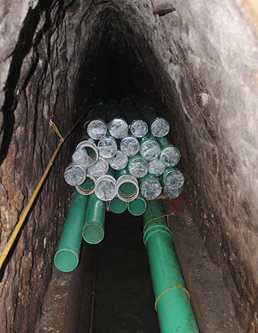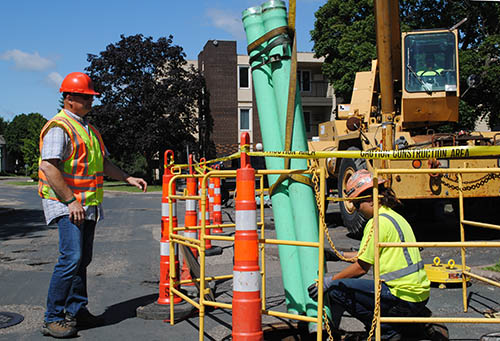A Metropolitan Council Environmental Services regional interceptor cleaning project this year on Saint Paul’s West Side has been an interesting mix of technology, geology, and sewer design and construction dating back to the mid-1930s.
“This sewer is unique because it’s one of a few of our sewers that was hand dug with pickaxes directly through the sandstone, which lies beneath a very thick layer of limestone,” said Dan Chouinard, an Environmental Services engineering project manager. “When I walked this sewer years ago, I thought it was really cool to still be able to see the original pickaxe marks on the walls.”
 An 84-year-old engineering drawing shows the tunnel, hand-mined through sandstone, was about 3½ feet wide and 6½ feet high. The concrete sewer trough built into the lower third of the tunnel – about 2½ feet wide and 2½ feet tall – was deep enough to handle regular wastewater flows. Occasional higher flows would wash over the higher sandstone walls for only short periods of time.
An 84-year-old engineering drawing shows the tunnel, hand-mined through sandstone, was about 3½ feet wide and 6½ feet high. The concrete sewer trough built into the lower third of the tunnel – about 2½ feet wide and 2½ feet tall – was deep enough to handle regular wastewater flows. Occasional higher flows would wash over the higher sandstone walls for only short periods of time.
After 80 years, concrete structure filled with debris
But an inspection in 2015 showed that in eight decades of use, most of the concrete structure in a 2,100-foot stretch of this interceptor had filled with debris, resulting in wastewater flowing through and eroding the upper cone of the soft sandstone.
“The debris built up so high that you couldn’t stand up straight to inspect the tunnel,” Chouinard said. “In some areas, sandstone has eroded up to 6 feet outward from the sewer, which permanently weakens the base material.” The sewer cleaning was completed in July, and engineers are looking at options to address the sandstone repairs that are now needed, he said.
Project avoided above-ground temporary sewer conveyance
The five months of sewer cleaning was preceded last spring with construction of an additional maintenance access hole about midway on this long stretch of sewer. It is about 9 feet wide and – given the bluffs that overlook the nearby Robert Street-Cesar Chavez Street intersection – about 67 feet deep.
 “The contractor did an amazingly efficient job at cleaning this sewer,” said Denny Stallman, an Environmental Services contract administrator for this project. “They were able to run the temporary wastewater conveyance piping inside the tunnel while they cleaned the sewer and got it done on schedule.”
“The contractor did an amazingly efficient job at cleaning this sewer,” said Denny Stallman, an Environmental Services contract administrator for this project. “They were able to run the temporary wastewater conveyance piping inside the tunnel while they cleaned the sewer and got it done on schedule.”
This plan avoided using above-ground wastewater conveyance pipes and the large pumps that would be needed to move the wastewater up the bluff before discharging it back into the interceptor. The contractor instead ran it by gravity through an 8-inch-diameter PVC pipe hung by straps from the tunnel wall.
“This rapid elevation change was a unique aspect of the project, and the contractor was very creative in addressing it,” Chouinard said.
Contractor removes 114 tons of debris from sewer
Once the new maintenance hole and wastewater conveyance system were in place, it was time to face the matter at hand – removing a small mountain of accumulated debris. High-pressure water jetting is a standard sewer cleaning method, but it would do too much damage to the sandstone tunnel wall. Instead, the contractor’s crews used loosened the gritty debris with shovels, and vactor trucks suctioned it out for eventual disposal in landfill.
About 114 tons of debris was removed from the sewer. About 1 ton of that were cobbles too big for the vactor suction tube – from the size of bricks to slightly larger than bowling balls. Also found in the debris were – wouldn’t you know it – several cell phones no longer fit for service.